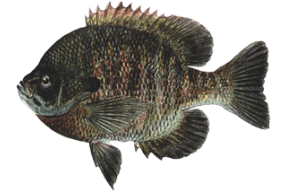Characteristics
Bluegills are one of the most passive fish out there. They are fun to catch and I would recommend anyone who is learning to fish to start out fishing for this type of species. You’ll get a clear understanding of fishing with this type of fish.
Although all fish are predators and will attack as a form of survival, I believe this fish goes along with the flow. Their form of attack can be just like a nip on your finger. They can grow up to 13” in length and can reach up to 2 pounds. However, most caught are smaller.
They get their name because of the blue tint on their scales. The tips of their gills are etched with black markings. For how small they can be, they fight very well for their size.
They are also great eating fish. Most people practice Catch N” Release, however, there are those who catch this fish to eat.
Habitat
Bluegills school together so if you find one fish, you’ll definitely find more. If you find large fish in the water, odds are you won’t find Bluegills in the same area because they tend to stay away from the large fish that eat them.
Depending on the season, They concentrate in one area. It’s great to see a school of this pan fish as they all respond the same when they surround you. Whether you’re fishing in a boat or sitting on a dock fishing, As a group, Blue Gills will gravitate towards you.
During the springtime the females spawn in sandy and stony bottoms near the shorelines. Males become very aggressive during this time because they are protecting their spawn. They tend to say closer to their spawn bed, which makes them easy to catch. After they spawn, they’re likely to move to weedy areas.
During spring and summer watch to see where the sun consistently shines on the lake and that is where you’ll want to fish. Bluegills have a tendency to stay in warmer water and closer to the shoreline.
During the fall and winter, they move toward deeper water because the shoreline gets colder and freezes. Deeper water is warmer.
The DNR is always working on the protection of fish habitat and maintaining a good balance of fish and the lake environment in an effort to keep fish well for anglers.
Equipment
The lighter the equipment the more fun it will be to catch the fish. Use ultra-light rods and reels and 4lb. test line as well as small to large size bobbers. Since they are smaller fish, you won’t need heavy equipment like you would for larger more aggressive fish.
Tips for Fishing
You can sit on a pier, hangout on the shoreline or wade off a boat when you‘re fishing for this pan fish. Since these are passive fish, compared to other fish, you’ll have a relaxing time fishing for Bluegills. So if you want to have a quite time fishing, this may be the fish for you.


